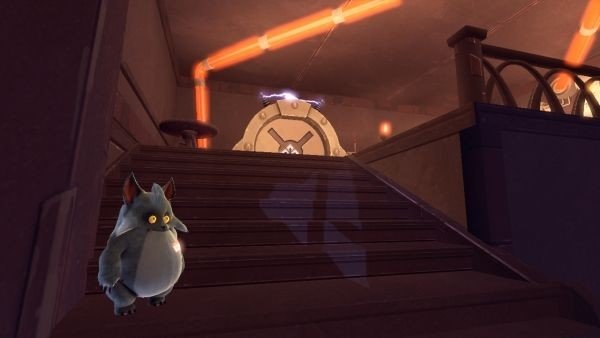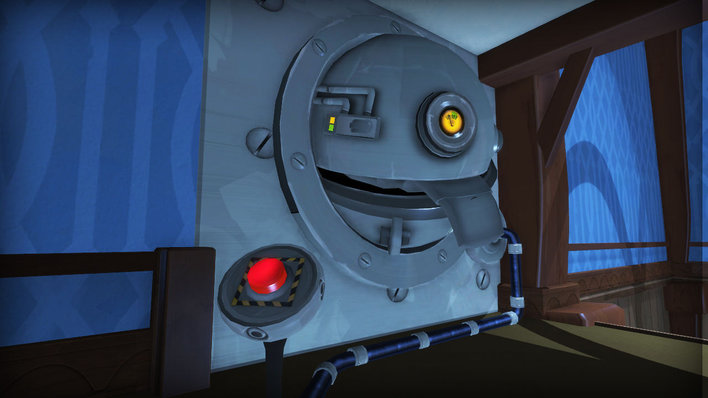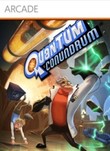It's always hard to follow on from a hit game - and it's even harder to follow on from a game like Portal. Bringing with it a charming mix of humour, a simple concept, and some devilishly tricky physics based puzzles, Portal was a game that garnered a huge following, thanks in no small part to being so utterly original. Based around a single, ingenious concept, Portal gave you a gun with which you could make two portals, that connected two points of the room together - walk through the one portal, and you'd appear in the other. It was a simple enough concept, yet it lent itself to countless possibilities - as Portal adequately demonstrated, as no two puzzles ever played out the same. Quantum Conundrum, out now on the Xbox Live Arcade, PS3 and PC, is a sequel of sorts to Portal, as the brainchild of one of the game's main designers - and the similarities are easy to see. A physics based puzzle game? Check. A disembodied voice providing direction as you explore a strange facility? Check. But is it just as good?
The idea behind Quantum Conundrum isn't quite as simple as the one behind Portal - although it does still have something to do with physics. Playing as an unnamed relative of crazy professor Fitz Quadwrangle, you arrive at the kooky Professor's mansion, ready to stay the night, only for one of the Professor's experiments to go wrong. Prof Quadrwangle then ends up getting trapped in another dimension - and, as you may imagine, it's up to you to get him out. Guided by the Professor's voice, you'll explore the various wings of the mansion, putting right the various experiments that are going wrong in each room by making use of a special "glove" that lets you jump between different dimensions. And it's this that's intended to be the mega-clever twist.

This is Ike, a little fluffy creature that you, sadly, only occasionally come across during your travels around the mansion.
By pressing a button, you can switch between alternate dimensions at any time - but rather than everything being different in each alternate dimension, instead, only the properties of the objects change. The four available dimensions are the fluffy dimension, which makes everything light; the heavy dimension, which, well, you can probably guess; the slow dimension, which makes everything move more slowly, and the reverse gravity dimension, which lightens gravity for every object in the room, bar yourself.
And while it may not be as simple a concept as Portal's portals, Quantum Conundrum's dimension shifting is certainly put to good use. Each of the rooms you come across in the mansion contains a puzzle that must be solved, usually under the guise of a malfunctioning machine, or a switch in an inaccessible area that somehow needs to be pressed. Solving them ranges from the fairly straightforward, to the incredibly complex. One of the early puzzles see you having to smash a glass window to get at a switch behind it. With a safe sitting on the ground next to you, all you have to do is switch to the fluffy dimension, pick up the safe with the X button (the fluffy dimension makes the safe so light you can happily pick it up), and chuck it at the glass window, switching back to the normal dimension just before the safe makes contact with the glass, at which point the safe regains its normal weight, and smashes straight through. Some of the trickier puzzles later on require you to make use of giant fans to build bridges in the fluffy dimension made out of crates. Faced with a giant chasm in between the platform you're standing on, and the platform you need to get to, the only other thing in the room with you is a giant fan built into the one wall, blowing a gale at you from your right hand side, and a few crates. In order to make it across, you'll need to pick up these crates one by one in the fluffy dimension, and drop them into the chasm, where the wind from the fan will take them, and force them against the wall, holding them in place, letting you construct a makeshift bridge. It's hard to talk too much about these puzzles without giving too much away, but needless to say, there are countless ways you'll have to make use of the various dimensions in order to progress through the game.
And it's in the experimentation, and the problem solving, that Quantum Conundrum starts to shine, as few of the puzzles can simply be aced first time. Upon entering a room, you'll have to stop, look around, and explore every nook and cranny before you even start to try and solve the puzzle, as having a mental inventory of the objects you have available goes a long way to helping you solve each challenge. One of the more intricate puzzles sees you having to stick a set of reactor cores into a number of large, towering vats, which are suspended above a bottomless pit. In order to get the cores into the vat, all you have to do is chuck them, like a basketball, towards the top of the vat - if you're lucky, they'll bounce around the rim, and drop down inside. But it's how you go about chucking them that's the interesting part. With the vats suspended well above human height, even jumping won't get you high enough - instead, you'll need a cunning plan.

The pressure pads (with the green jet bit) are your friends.
Getting the reactor inside the first vat is fairly straightforward. Picking up a crate, you wonder over to a pressure pad, which works like a giant spring, and plonk the crate on top of it. Switch to the heavy dimension, and you give the crate the added weight it needs to squidge the pressure plate down - effectively priming our invisible spring. Holding the reactor core tightly, you leap up on top of the crate, like an experimental human cannonball, and switch things back to normal, flinging you, the crate, and the reactor into the air. Time it right, and you'll chuck the core inside the vat. Great - that's one down, and the second is fairly straightforward too - but what about the last one?
Getting the reactor inside the remaining vat was actually one of the best puzzles we came across (so feel free to skip this next paragraph if you don't want to spoil it for yourself). Positioned next to a large path, you have four of the springy pressure pads at your disposal - two fairly close to the vat you're aiming for, and two at either end of the path, positioned at 45 degree angles. You also have your trusty crate. What you have to do is both complex, yet simple, and incredibly cool once you've figured it out. Placing your reactor core on the flat pressure pad near the vat, you take your crate to the angled one at the end of the path, switch to the heavy dimension, and climb on top, in a similar way to before. Crossing yourself for luck, you switch back to normal, and watch as you get flung into the air and down the path, just in time to catch the reactor core in mid-air as it reaches its apex, before turning slightly, adjusting your aim, and chucking it into the vat from mid-air. Complex? Yes. Awesome? Definitely.
However, as brain teasing as many of the puzzles in Quantum Conundrum are, there are a few recurring themes that'll have you groaning every time they rear their ugly heads. Arguably the worst of the bunch is the game's bizarre love of first-person platforming, which basically sees you having to judge, with pixel perfect precision, the leaps of faith you have to take, without being able to see either your character, or your feet. It's incredibly hard to get these jumps exactly right, because of the perspective you're playing from, and as such, it can lead to one too many untimely deaths. Never is this more obvious than when you first reach the slow dimension, and are required to leap across a set of falling tables, chairs, and boxes, before they fall too far. Managing to jump from one object to the next is hard enough - being expected to do it with a strict time limit is a tad too much. First person platforming is never a good thing, and the reliance on it here is more than a bit disappointing.
But it's not just the first-person platforming. For some reason, things seem to have been made a lot more difficult in Quantum Conundrum than they really should be - and we're not quite sure why. Whether it was in an attempt to try and appeal to a more hardcore audience, or simply a case of balancing gone wrong, some of the puzzles can be very, very difficult - not in terms of figuring out what you have to do, but rather in terms of the obstacles you're presented with. Asking you to dodge lasers that kill you if they touch you for more than a second, judge your throws perfectly (without any sort of on-screen aiming line to show you where your object's going to go), or make your way through a course within a very strict time limit, there's a much greater demand on your controller skills here than there was in similar games, like Portal - so we'd recommend trying the demo out first.

These friendly looking things spit out objects when you hit the button.
But it's not just the slight repetitive nature of the puzzles, and the over reliance on the world's most awkward form of jumping that's the bigger problem here - mostly, it's that something just feels like it's missing. Portal was a game that had a soul - it was funny, it had character, it had charm, and you wanted to keep playing. Though it may try, Quantum Conundrum has none of that. The Professor's so dull and utterly unfunny you find yourself cringing every time he talks, and while Ike, the cute little creature that rears his fluffy head from time to time is a nice enough character, he rarely ever really make his presence felt. He's less a character, and more a furry object. Perhaps Ike should have been the professor instead. He certainly has more personality.
In all, Quantum Conundrum is still a decent enough puzzle game, let down by some awkward first person platforming, and a lack of character. While the dimension switching idea may not have the same "Eureka!" feel as Portal, there's still enough here to provide some real head scratching puzzles, and plenty of satisfaction when you eventually figure them out. With a bit more personality, a little bit more variety in the puzzles, and a toning down of the difficulty, Quantum Conundrum could have reached much greater heights.
Format Reviewed: Xbox 360



















